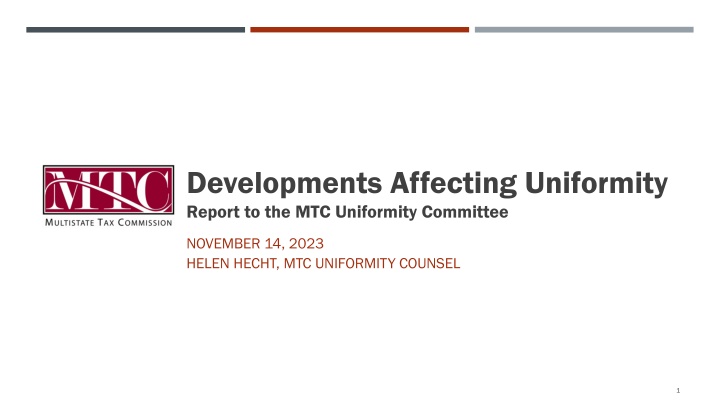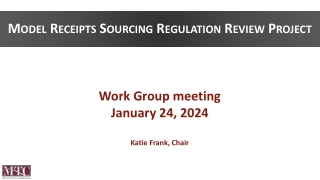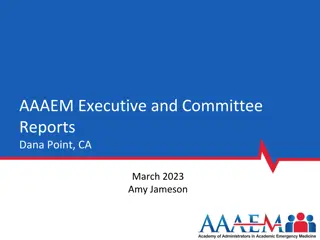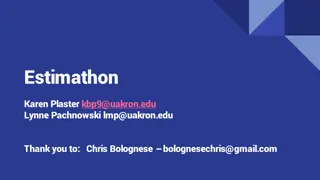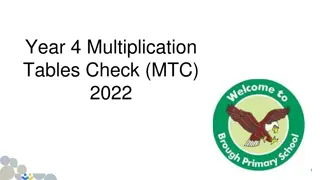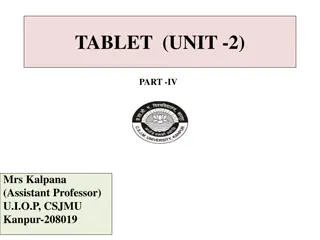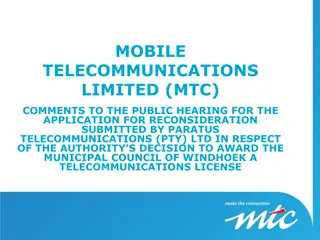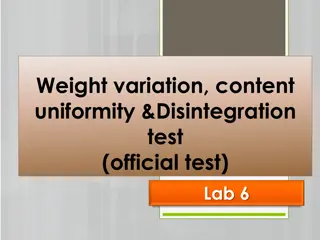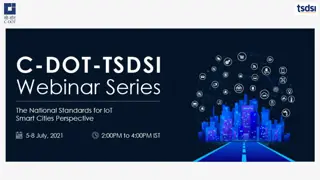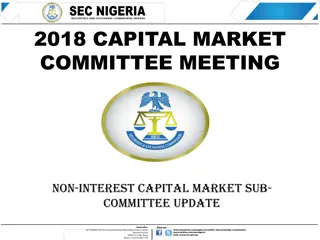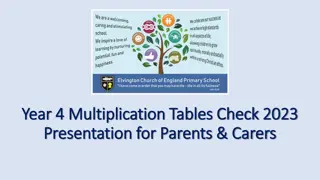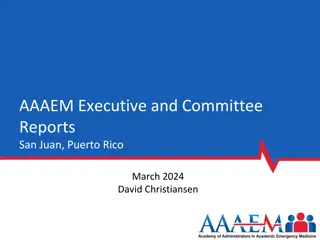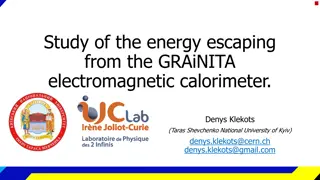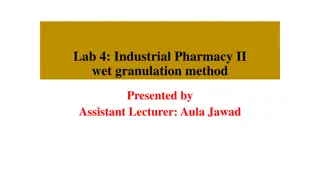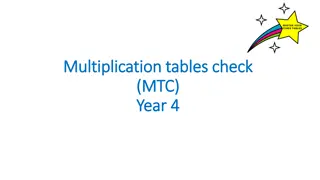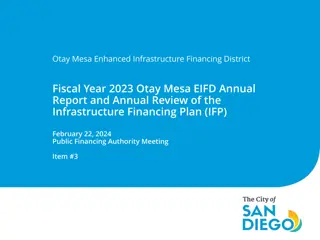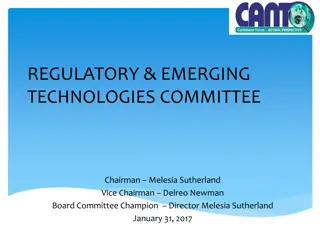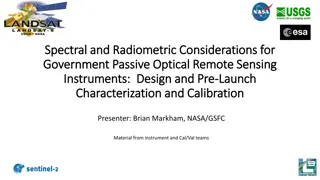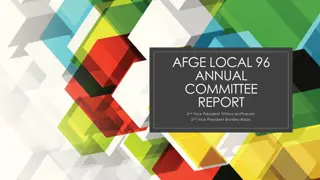Developments Affecting Uniformity Report to the MTC Uniformity Committee
Market-based sourcing models and OECD's Pillar One framework are detailed in the report by Helen Hecht to the MTC Uniformity Committee. The report discusses the challenges of sourcing income from the digital economy and emphasizes the importance of using reliable methods for market-based sourcing principles.
Download Presentation

Please find below an Image/Link to download the presentation.
The content on the website is provided AS IS for your information and personal use only. It may not be sold, licensed, or shared on other websites without obtaining consent from the author.If you encounter any issues during the download, it is possible that the publisher has removed the file from their server.
You are allowed to download the files provided on this website for personal or commercial use, subject to the condition that they are used lawfully. All files are the property of their respective owners.
The content on the website is provided AS IS for your information and personal use only. It may not be sold, licensed, or shared on other websites without obtaining consent from the author.
E N D
Presentation Transcript
Developments Affecting Uniformity Report to the MTC Uniformity Committee NOVEMBER 14, 2023 HELEN HECHT, MTC UNIFORMITY COUNSEL 1
MTC MARKET-BASED SOURCING MODEL STATUTE 17. (a) Receipts . . . .are in this State if the taxpayer s market for the sales is in this state. The taxpayer s market for sales is in this state: . . . delivered to a location in this state; and (3) in the case of sale of a service, if and to the extent the service is (4) in the case of intangible property [generally based on location of use] (b) If the state or states of assignment under subsection (a) cannot be determined, the state or states of assignment shall be reasonably approximated. . . . 3
OECD FINALIZING PILLAR ONE FRAMEWORK Pillar One is based on the determination that income from the digital economy cannot be sourced using the traditional separate accounting approach. See report issued in October 2023 The Multilateral Convention to Implement Amount A of Pillar One available here: https://www.oecd.org/tax/beps/multilateral-convention-to-implement- amount-a-of-pillar-one.pdf. 4
OECD PILLAR ONE IN GENERAL Excess profit ( Amount A ) of any large MNE is deemed to be from the digital economy. Amount A is apportioned using a single receipts-factor formula with market-based sourcing. Nexus to impose tax is also based on that sales factor. Relief is provided if excess income taxed in all jurisdictions exceeds total excess income. 5
OECD PILLAR ONE SOURCING APPROACH Market-based sourcing under Pillar One Requires taxpayers use a reliable method Consistent over time and between jurisdictions Based on proper records, etc. Reliable method must also be based on general sourcing principles . 6
PILLAR ONE SOURCING PRINCIPLES INCLUDE: Sale of goods Delivery to the ultimate customer. If made to a business that resells or uses the goods as a component of the ultimate product look through. Otherwise location of delivery to the business. 7
PILLAR ONE SOURCING PRINCIPLES INCLUDE: Services Location-specific services performed on property to location of property. Other services to location where service is performed. 8
PILLAR ONE SOURCING PRINCIPLES INCLUDE: Intangible property If related to finished goods or components to location where goods (including components) are delivered to the ultimate customer. If the IP supports a service or digital content to location where service or digital content is used. Otherwise - to location of use. 9
PILLAR ONE SOURCING PRINCIPLES INCLUDE: Advertising related Online advertising to location(s) of viewers. Other advertising to location(s) where ad is displayed. Licensing or sale of user data to location of those users. 10
PILLAR ONE SOURCING PRINCIPLES INCLUDE: Transportation services Passengers to location where passengers disembark (other than intermediate stops). Goods 50% to where goods are loaded and 50% to where goods are unloaded from taxpayer s vehicle or vessel (other than intermediate stops). 11
DIGITAL TRANSFORMATION What is it? (Google it.) A process businesses are going through to incorporate all kinds of digital technology, and the tools made available by that technology, in every aspect of their work, including: Administrative and management processes; Product development and offerings of new products and services; Advertising, promotion, and customer experiences. 13
DIGITAL TRANSFORMATION - EXAMPLES Replacing physical work spaces with technologies allowing employees to work from any location. Using digital technology to automate supply chains and the logistics of storing and moving physical goods. Replacing accountants and older financial systems with technologies like distributed ledger-based record-keeping and AI tools for research. Developing new services that identify and share data in new ways, such as combining and filtering. 14
BACKGROUND Worst kept secret IRS could not effectively audit large partnerships. In 2015, Congress passed the Bipartisan Budget Act (BBA). The BBA established a centralized partnership audit process for years starting in 2018, allowing the partnership to be audited and assessed for any adjustments and effectively shifting the burden to the partnership to show why proposed adjustments should not be made. But it has not been clear whether this centralized audit regime would be effective in auditing partnerships in complex structures. 16
IRS ANNOUNCES IT WILL USE AI TO AUDIT LARGE PARTNERSHIPS IRS began announcing its plans after the GAO came out with a report in July, entitled: IRS Audit Processes Can Be Strengthened to Address a Growing Number of Large, Complex Partnerships, available here https://www.gao.gov/products/gao-23-106020. According to IRS Commissioner Werfel: "The IRS has simply not had enough resources or staffing to address partnerships. In a real sense, we've been overwhelmed in this area for years. That is beginning to change today." 18
GAO REPORT DISCUSSION GROUPS WITH IRS STAFF In all four of our discussion groups with IRS staff, they highlighted the level of complexity associated with partnership structures as a challenge; three of our four discussion groups mentioned the complexity of partnership law and partnerships having multiple tiers and complex structures. In September 2022, IRS completed its overall partnership strategy in which it stated partnership tax law is among the most complex in tax law. 19
ACCORDING TO ACCOUNTING TODAY (SEPT. 8, 2023) IRS hopes that the use of AI technology will aid its efforts to audit large partnerships: "The complex structures and tax issues present in large partnerships require a focused approach to best identify the highest-risk issues and apply resources accordingly," said Werfel. "We are using artificial intelligence to help with this effort. 20
ACCORDING TO ACCOUNTING TODAY (SEPT. 8, 2023) "With the help of AI, the selection of these partnership returns for review is the result of groundbreaking collaboration among experts in data science and tax enforcement," said Werfel. . . . Essentially, these new tools are helping us see patterns and trends that we could not see before. As a result, we have higher confidence on where to look and find where large partnerships are shielding income." 21
ACCORDING TO ACCOUNTING TODAY (SEPT. 8, 2023) The IRS will start with 75 specific partnerships, each with assets over $10 billion on average, "These are some of the largest in the U.S. that the AI tool helps us identify," said Werfel. "These organizations will be notified of the audit in the coming weeks." 22
MTC RECOMMENDATIONS At it s 2022 meeting, the MTC adopted a resolution recommending that states that adopt the MTC s revised statement on P.L. 86-272 also adopt the factor presence nexus standard, which the MTC adopted in 2002. States will also need to consider prospective adoption and application of the standard to any throw-back rules. 24
STATE ACTIONS In September, New Jersey updated guidance on economic nexus releasing a technical bulletin after state lawmakers enacted a bright-line threshold. The guidance generally follows the revised statement on P.L. 86-272 (and applies Finnigan). See here: https://www.nj.gov/treasury/taxation/pdf/pubs/tb/tb108.pdf. 25
STATE ACTIONS New York is in the process of considering comments on its proposed adoption of rules that also generally track the revised statement, including comments that related rules be given prospective effect. 26
DEFINITION OF THE WATERS EDGE GROUP Pepsico Inc. v. Illinois Department of Revenue (on appeal) shows how excluding certain domestic subsidiaries from the water s edge combined group allows corporations to easily shift profits to non-taxed entities. 28
PROBLEM OF 80/20 COMPANIES Under Illinois law, and the law of a dozen other states: The water s edge group excludes entities: Wherever incorporated or headquartered: Whose business activity outside the United States is 80 percent or more of [their] total business activity. Business activity is measured solely by the amount of a business s payroll and property. 29
PROBLEM OF 80/20 COMPANIES So a domestic entity headquartered in the US might be excluded from the group if more than 80% of its payroll and property are outside the U.S. Regardless of how much the entity might have in domestic receipts, and Regardless of whether those receipts are from intercompany transactions. 30
PROBLEM OF 80/20 COMPANIES Use of these so-called 80/20 companies prompted counsel for the MTC to publish articles: Troubling Tax Behavior Illustrates Need to Change State Tax Codes, Brian Hamer, Tax Notes State, Jan. 30, 2023; and Pepsi Tax Case Shows Why 80/20 Rules Hurt States, Bruce Fort, Bloomberg Government, Nov. 7, 2023. 31
MTC COMBINED FILING MODELS (JOYCE & FINNIGAN) In comparison the MTC combined filing models, would include the income and factors of all domestic entities as well as any foreign entities if 20% or more of the entity s factors, including sales, are domestic. See those models, here: https://www.mtc.gov/uniformity/adopted-uniformity- recommendations/. Also, the MTC has a model requiring add-back of certain expenses from intercompany transactions. 32
MOORE States have long conformed to federal tax base, which simplifies the state income tax system and makes it more uniform. In Moore v. United States, the Supreme Court may void certain provisions of the Internal Revenue Code if they determine that the term income as used in the Sixteenth Amendment includes an implicit realization requirement. States that conform to the IRC, especially those that conform by starting their calculation of state tax with the amount of properly reported federal taxable income or AGI, may also be affected. Arguments in the case are to be held on December 5, 2023. 34
QUESTIONS? 35
